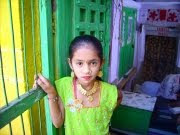 The world’s hottest chilli could soon become the new weapon of Indian security forces to take on insurgents or rioters. Naga Jolokia or Bhut Jolokia, meaning “ghostly chilli”, gets its name from its deadly bite and is reported to be 1000 times hotter than the ordinary kitchen chilli.
The world’s hottest chilli could soon become the new weapon of Indian security forces to take on insurgents or rioters. Naga Jolokia or Bhut Jolokia, meaning “ghostly chilli”, gets its name from its deadly bite and is reported to be 1000 times hotter than the ordinary kitchen chilli.With the pattern of wars around the world changing to more low-intensity conflicts, scientists at various Defence Research and Development Organisation (DRDO) laboratories are working on a project for developing teargas canisters and hand grenades stuffed with Bhut Jolakia chillies from Assam. “The trials have been done for the hand grenades. It gives out such pungent smoke that it makes one come out of one’s hiding place,” explains RB Srivastava, the director of the Directorate of Life Sciences at DRDO.
The chilli grenades devised by the DRDO could numb the enemy and immobilise them without serioulsy wounding or even killing them. The Defence Research Laboratory (DRL) at Tezpur in Assam was established after extensive research that the Naga chilli can be turned into a grenade without being lethal. Ordinary tear gas, used to disperse rioters, affects the eyes and can be tolerated by holding a wet cloth to the face. However, “the chilli bomb would choke the respiratory system too and the person can even go into a semiconscious state,” says Srivastava, who was once Director of the DRL and who knows a lot about the properties of the chilli.
The scientist explains, “War scenario is changing. Low intensity conflict is the norm of the day. The paramilitary forces face the problem of forcing the terrorists out of their hideouts. Nowadays even a handful of people can take the country for ransom.” Thus, the chilli bomb could be a perfect non-lethal way to tackle insurgents and mobs. “One hand chilli grenade would be enough to make an impact in a room. The after-effects would be felt for about 20 minutes,” states Srivastava.
.
Bhut Jolokia was recognised in 2007 by the Guinness Book of World Records the hottest chilli in the world. The hotness or pungency of a chilli is usually measured in Scoville heat units (SHUs), that is, the amount of capsaicin (an active compound of chilli peppers) present. Capsaicin is an irritant that produces a burning sensation on tissue when it comes in contact with it. In 2000, the DRL said it had discovered a chilli with more than 800.000 SHUs. Later experiments by independent scientists showed that the pungency of the Bhut Jolakia chillies measured over a million SHUs, which is nearly twice as hot as Mexico’s Red Savina Habaneros (more than 500.000 SHUs). By comparison, a new Mexico green chilli contains only about 1.500 SHUs
From this discovery, the chilli samples were sent to the DRDO laboratory in Gwalior (Madhya Pradesh) to study its effects on the human body. Then, it was sent to the High-Explosive Material Research Laboratory in Pune (Maharashtra), which brought it out in the form of hand grenades.
Thereafter, a range of other plans to use the Bhut Jolokia chilli emerged. “It can be used in sprays by women to scare away eve teasers,” says Srivastava, adding: “We are also trying for a scientific validation to find out if Bhut Jolokia could be incorporated into the food menus for soldiers in higher reaches to keep them warm.” Not only that, the extracts of the chilly, exported to the US where it is a favourite among foodies, can also be used as powder to drive away animals. For instance, “we have found that elephants are scared of this chilli. So nylon ropes spread with chilli powder can be used to encircle camps to keep away the jumbos” in some part of Assam and other northeastern states, says Srivastava.
The Bhut Jolokia is both a formidable weapon and an organic product, cultivated in Assam by the State Agriculture Department. Pramila Rani Brahma, State agriculture minister, has instructed the directorate of horticulture and food processing to promote cultivation of the chilli in Golaghat and Baksa districts under Technology Mission for Horticulture Development. Last month, Brahma declared the area of Naga Jolokia cultivation in Assam has to be increased because of its high export value. She added that incentives would be sent to farmers who opt for cultivating this special chilli by the directorate of horticulture and food processing.

